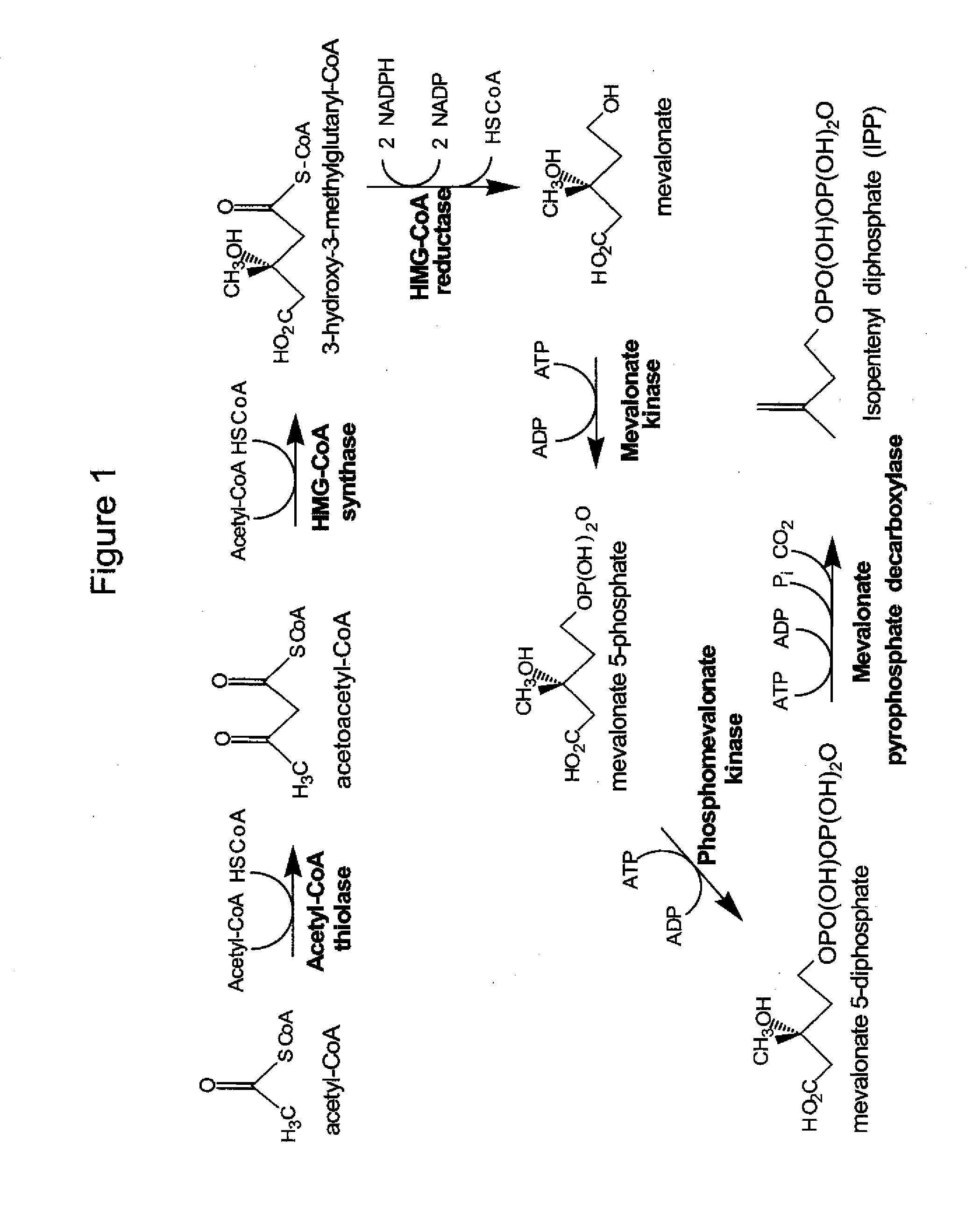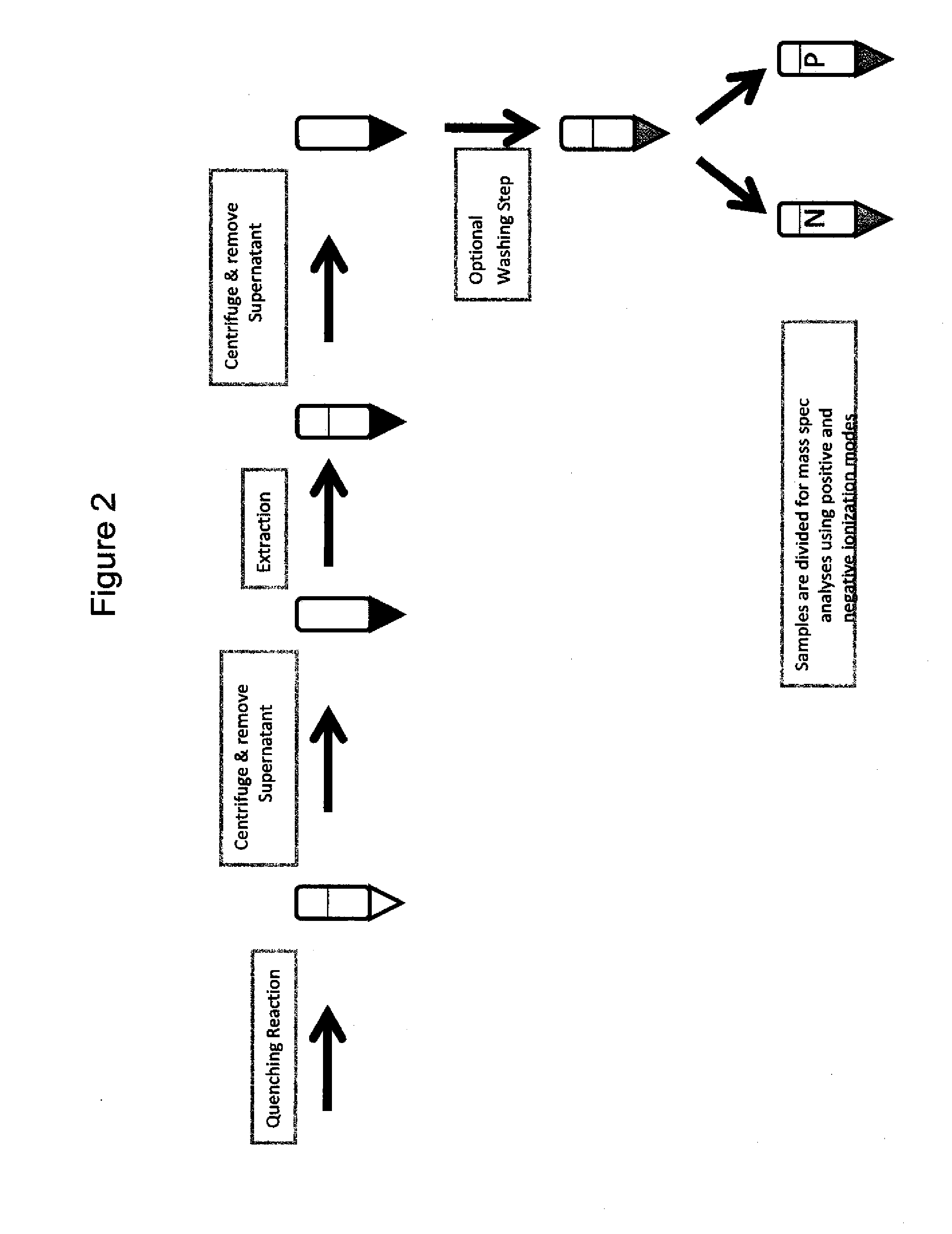Methods of Monitoring Metabolic Pathways
- Summary
- Abstract
- Description
- Claims
- Application Information
AI Technical Summary
Benefits of technology
Problems solved by technology
Method used
Image
Examples
example 1
[0158]LC / MS / MS was used to evaluate a set of standards representing mevalonate pathway metabolites and co-factors. The objective was to verify that both the metabolites and co-factors can be detected using the desired LC / MS / MS procedure.
[0159]Study Design. Standards of the mevalonate pathway metabolite and co-factors were prepared and analyzed using LC / MS / MS and used to determine expected retention times. Metabolites were analyzed using P and N modes as mentioned below.
[0160]Buffer Preparation. Ammonium Acetate Buffer—38.5 g ammonium acetate was added to 500 mL of 1 M Ammonium acetate in LC / MS grade water. The mixture was transferred to a 500 mL graduated cylinder. Water was added to make up 500 mL and the buffer was stored at 4° C. for future use.
[0161]1 M Ammonium Hydroxide Buffer −17.5 g was added to HPLC grade water to a volume of 500 mL and stored at 4° C. for future use.
[0162]LC Solvent—To a clean LC solvent bottle and fresh pipettes, 960 mL of LC / MS grade water, 20 mL of ammo...
example 2
[0171]S. cerevisiae or E. coli was grown in either shake flasks or fermentors with or without isopropyl myristate overlay. Cell samples from were extracted and mevalonate pathway metabolites and co-factors were analyzed using LC / MS / MS. The objective is to verify that intracellular mevalonate pathway metabolites and co-factors can be detected and that those metabolites and co-factors can be quantified.
[0172]Study Design. Cell samples were prepared using a basic extraction method that allows for quantification of coA co-factors and other mevalonate pathway metabolites and co-factors. Using the LC / MS / MS procedure and results described in Example 1, intracellular metabolites and cofactors were identified and quantified. Linearity and reproducibility of the measured relative concentration was also evaluated.
[0173]Summary of the Extraction Procedure. Generally, the extraction procedure involves immediately quenching the harvested cells using −80° C. methanol. The mixture is then centrifug...
example 3
[0182]The extraction method was performed at multiple conditions to achieve high stability and recovery of MEV pathway metabolites and co-factors. Efforts were made to ensure stability and recovery of CoA containing metabolites, non-coA containing metabolites, and co-factors.
[0183]Study Design. The following parameters were investigated for highest stability and recovery of MEV pathway metabolites and co-factors: extraction solvent pH, ratio of extraction solvent to broth, number of extractions, acidification of the extracted metabolites.
[0184]Results. The effects of extraction solvent pH on recovery of metabolites and co-factors are shown in FIG. 4. Higher recovery of several co-factors and metabolites, including NADH and FPP, were observed when a basic extraction buffer was used. A higher recovery level of both NADP and NADPH was observed when the broth to extraction solvent ratio was 1:2 (versus a 1:1 and 1:4). Higher recovery of the MEV pathway metabolites and co-factors was obs...
PUM
| Property | Measurement | Unit |
|---|---|---|
| Temperature | aaaaa | aaaaa |
| Temperature | aaaaa | aaaaa |
| Temperature | aaaaa | aaaaa |
Abstract
Description
Claims
Application Information
 Login to View More
Login to View More - R&D
- Intellectual Property
- Life Sciences
- Materials
- Tech Scout
- Unparalleled Data Quality
- Higher Quality Content
- 60% Fewer Hallucinations
Browse by: Latest US Patents, China's latest patents, Technical Efficacy Thesaurus, Application Domain, Technology Topic, Popular Technical Reports.
© 2025 PatSnap. All rights reserved.Legal|Privacy policy|Modern Slavery Act Transparency Statement|Sitemap|About US| Contact US: help@patsnap.com



